ACC302: Auditing and Assurance Report: Woolworths Financial Analysis
VerifiedAdded on 2023/01/19
|9
|2259
|79
Report
AI Summary
This report provides an in-depth analysis of the auditing and assurance practices of Woolworths Limited, an ASX-listed retail company. The report begins with an introduction outlining the scope of the analysis, focusing on the application of analytical procedures during the planning phase of an audit. Part A delves into the analytical review of Woolworths' financial statements, examining key items such as sales revenue, operating profit, net profit, inventory, and capital structure. It assesses the impact of these analyses on management's assertions and identifies areas of concern, such as the low inventory turnover and the capital structure. The report then details the necessary audit procedures to address these concerns, including verifying the reasons for the capital structure and conducting physical inventory counts. Part B shifts the focus to corporate governance, discussing the processes relating to corporate governance within Woolworths' annual report and the role of the audit committee. It examines the composition of the audit committee, its benefits to the auditor, the company, the auditing profession, and society as a whole. The report concludes by summarizing the key findings and emphasizing the importance of effective auditing and corporate governance in maintaining transparency and accountability.
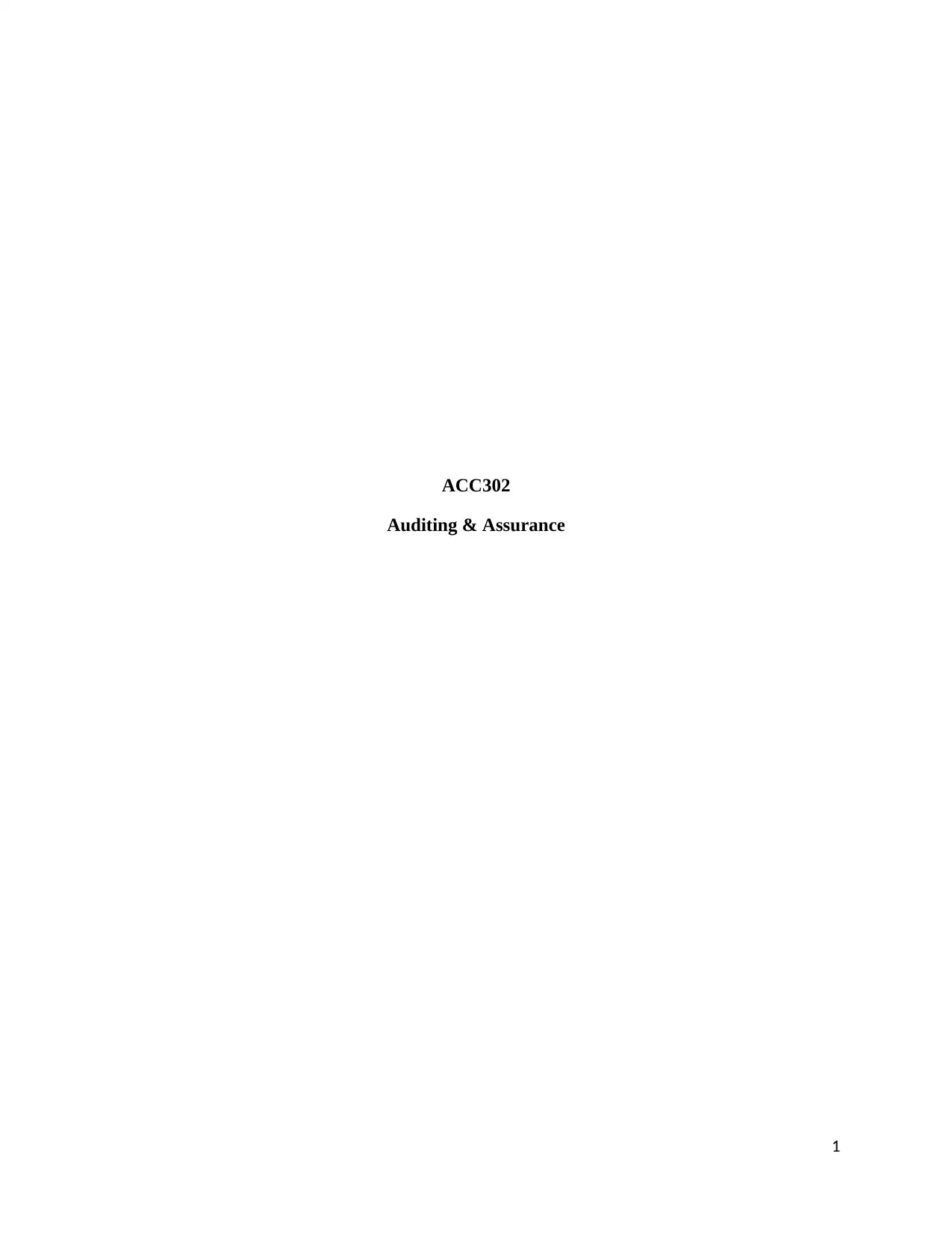
ACC302
Auditing & Assurance
1
Auditing & Assurance
1
Paraphrase This Document
Need a fresh take? Get an instant paraphrase of this document with our AI Paraphraser
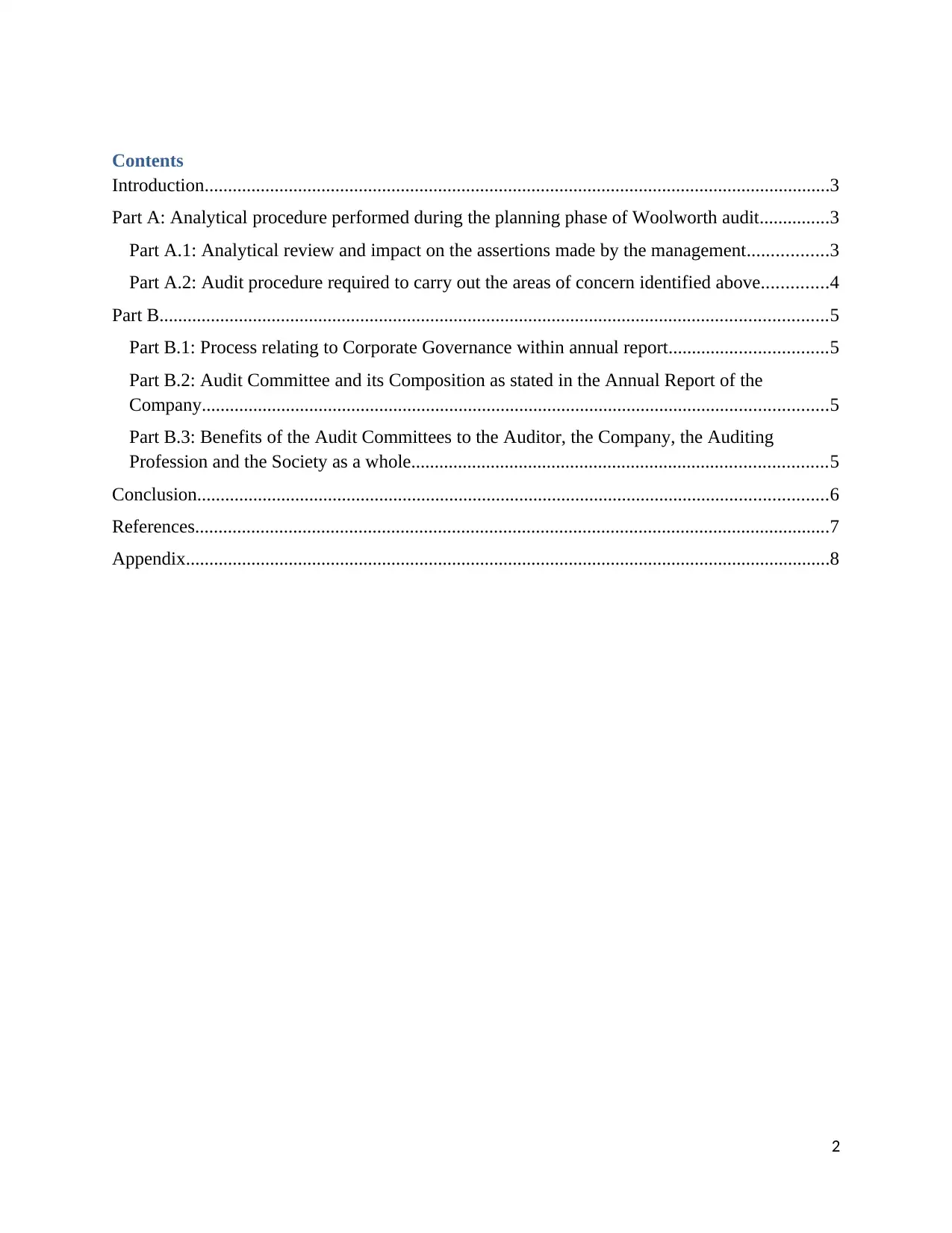
Contents
Introduction......................................................................................................................................3
Part A: Analytical procedure performed during the planning phase of Woolworth audit...............3
Part A.1: Analytical review and impact on the assertions made by the management.................3
Part A.2: Audit procedure required to carry out the areas of concern identified above..............4
Part B...............................................................................................................................................5
Part B.1: Process relating to Corporate Governance within annual report..................................5
Part B.2: Audit Committee and its Composition as stated in the Annual Report of the
Company......................................................................................................................................5
Part B.3: Benefits of the Audit Committees to the Auditor, the Company, the Auditing
Profession and the Society as a whole.........................................................................................5
Conclusion.......................................................................................................................................6
References........................................................................................................................................7
Appendix..........................................................................................................................................8
2
Introduction......................................................................................................................................3
Part A: Analytical procedure performed during the planning phase of Woolworth audit...............3
Part A.1: Analytical review and impact on the assertions made by the management.................3
Part A.2: Audit procedure required to carry out the areas of concern identified above..............4
Part B...............................................................................................................................................5
Part B.1: Process relating to Corporate Governance within annual report..................................5
Part B.2: Audit Committee and its Composition as stated in the Annual Report of the
Company......................................................................................................................................5
Part B.3: Benefits of the Audit Committees to the Auditor, the Company, the Auditing
Profession and the Society as a whole.........................................................................................5
Conclusion.......................................................................................................................................6
References........................................................................................................................................7
Appendix..........................................................................................................................................8
2
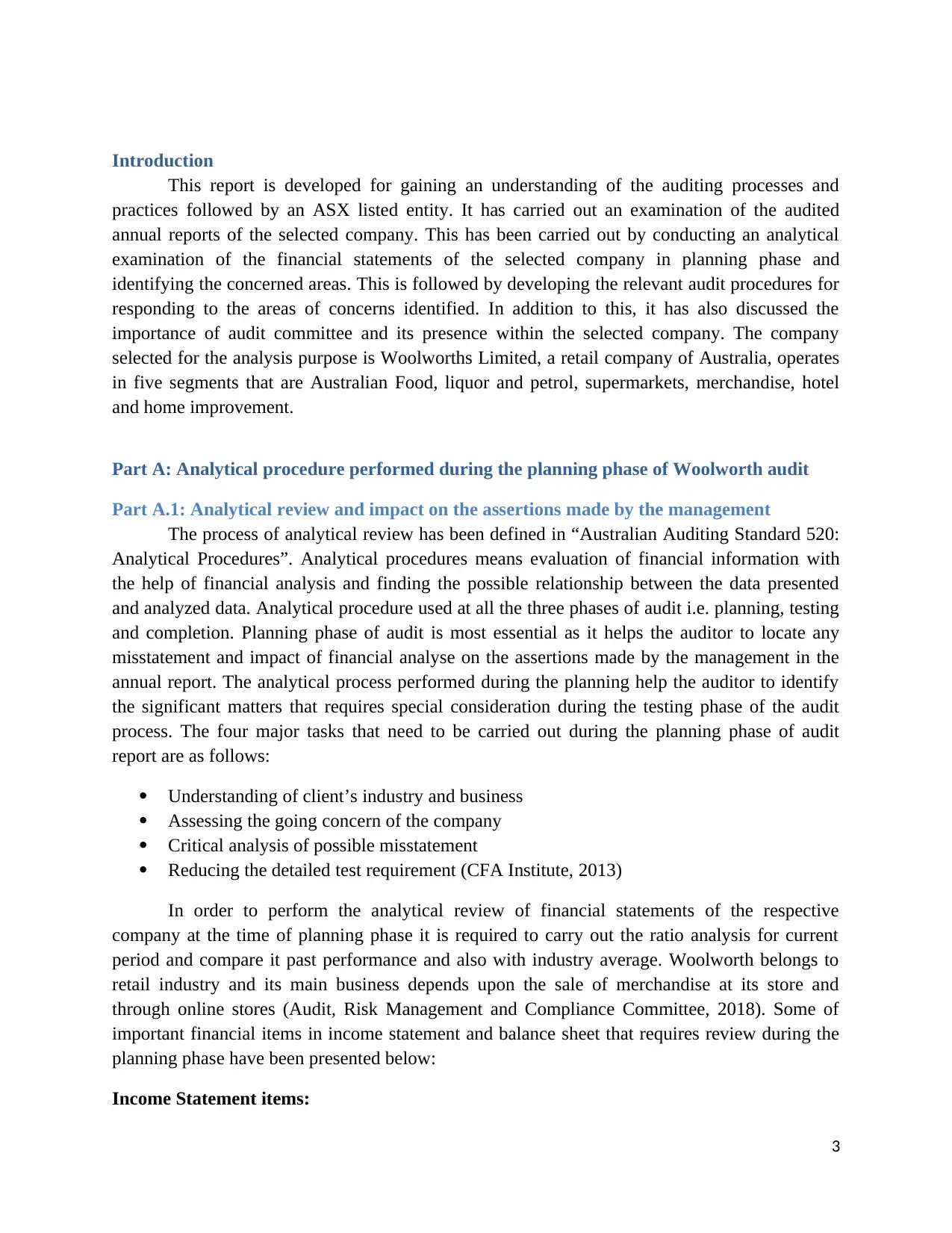
Introduction
This report is developed for gaining an understanding of the auditing processes and
practices followed by an ASX listed entity. It has carried out an examination of the audited
annual reports of the selected company. This has been carried out by conducting an analytical
examination of the financial statements of the selected company in planning phase and
identifying the concerned areas. This is followed by developing the relevant audit procedures for
responding to the areas of concerns identified. In addition to this, it has also discussed the
importance of audit committee and its presence within the selected company. The company
selected for the analysis purpose is Woolworths Limited, a retail company of Australia, operates
in five segments that are Australian Food, liquor and petrol, supermarkets, merchandise, hotel
and home improvement.
Part A: Analytical procedure performed during the planning phase of Woolworth audit
Part A.1: Analytical review and impact on the assertions made by the management
The process of analytical review has been defined in “Australian Auditing Standard 520:
Analytical Procedures”. Analytical procedures means evaluation of financial information with
the help of financial analysis and finding the possible relationship between the data presented
and analyzed data. Analytical procedure used at all the three phases of audit i.e. planning, testing
and completion. Planning phase of audit is most essential as it helps the auditor to locate any
misstatement and impact of financial analyse on the assertions made by the management in the
annual report. The analytical process performed during the planning help the auditor to identify
the significant matters that requires special consideration during the testing phase of the audit
process. The four major tasks that need to be carried out during the planning phase of audit
report are as follows:
Understanding of client’s industry and business
Assessing the going concern of the company
Critical analysis of possible misstatement
Reducing the detailed test requirement (CFA Institute, 2013)
In order to perform the analytical review of financial statements of the respective
company at the time of planning phase it is required to carry out the ratio analysis for current
period and compare it past performance and also with industry average. Woolworth belongs to
retail industry and its main business depends upon the sale of merchandise at its store and
through online stores (Audit, Risk Management and Compliance Committee, 2018). Some of
important financial items in income statement and balance sheet that requires review during the
planning phase have been presented below:
Income Statement items:
3
This report is developed for gaining an understanding of the auditing processes and
practices followed by an ASX listed entity. It has carried out an examination of the audited
annual reports of the selected company. This has been carried out by conducting an analytical
examination of the financial statements of the selected company in planning phase and
identifying the concerned areas. This is followed by developing the relevant audit procedures for
responding to the areas of concerns identified. In addition to this, it has also discussed the
importance of audit committee and its presence within the selected company. The company
selected for the analysis purpose is Woolworths Limited, a retail company of Australia, operates
in five segments that are Australian Food, liquor and petrol, supermarkets, merchandise, hotel
and home improvement.
Part A: Analytical procedure performed during the planning phase of Woolworth audit
Part A.1: Analytical review and impact on the assertions made by the management
The process of analytical review has been defined in “Australian Auditing Standard 520:
Analytical Procedures”. Analytical procedures means evaluation of financial information with
the help of financial analysis and finding the possible relationship between the data presented
and analyzed data. Analytical procedure used at all the three phases of audit i.e. planning, testing
and completion. Planning phase of audit is most essential as it helps the auditor to locate any
misstatement and impact of financial analyse on the assertions made by the management in the
annual report. The analytical process performed during the planning help the auditor to identify
the significant matters that requires special consideration during the testing phase of the audit
process. The four major tasks that need to be carried out during the planning phase of audit
report are as follows:
Understanding of client’s industry and business
Assessing the going concern of the company
Critical analysis of possible misstatement
Reducing the detailed test requirement (CFA Institute, 2013)
In order to perform the analytical review of financial statements of the respective
company at the time of planning phase it is required to carry out the ratio analysis for current
period and compare it past performance and also with industry average. Woolworth belongs to
retail industry and its main business depends upon the sale of merchandise at its store and
through online stores (Audit, Risk Management and Compliance Committee, 2018). Some of
important financial items in income statement and balance sheet that requires review during the
planning phase have been presented below:
Income Statement items:
3
⊘ This is a preview!⊘
Do you want full access?
Subscribe today to unlock all pages.

Trusted by 1+ million students worldwide
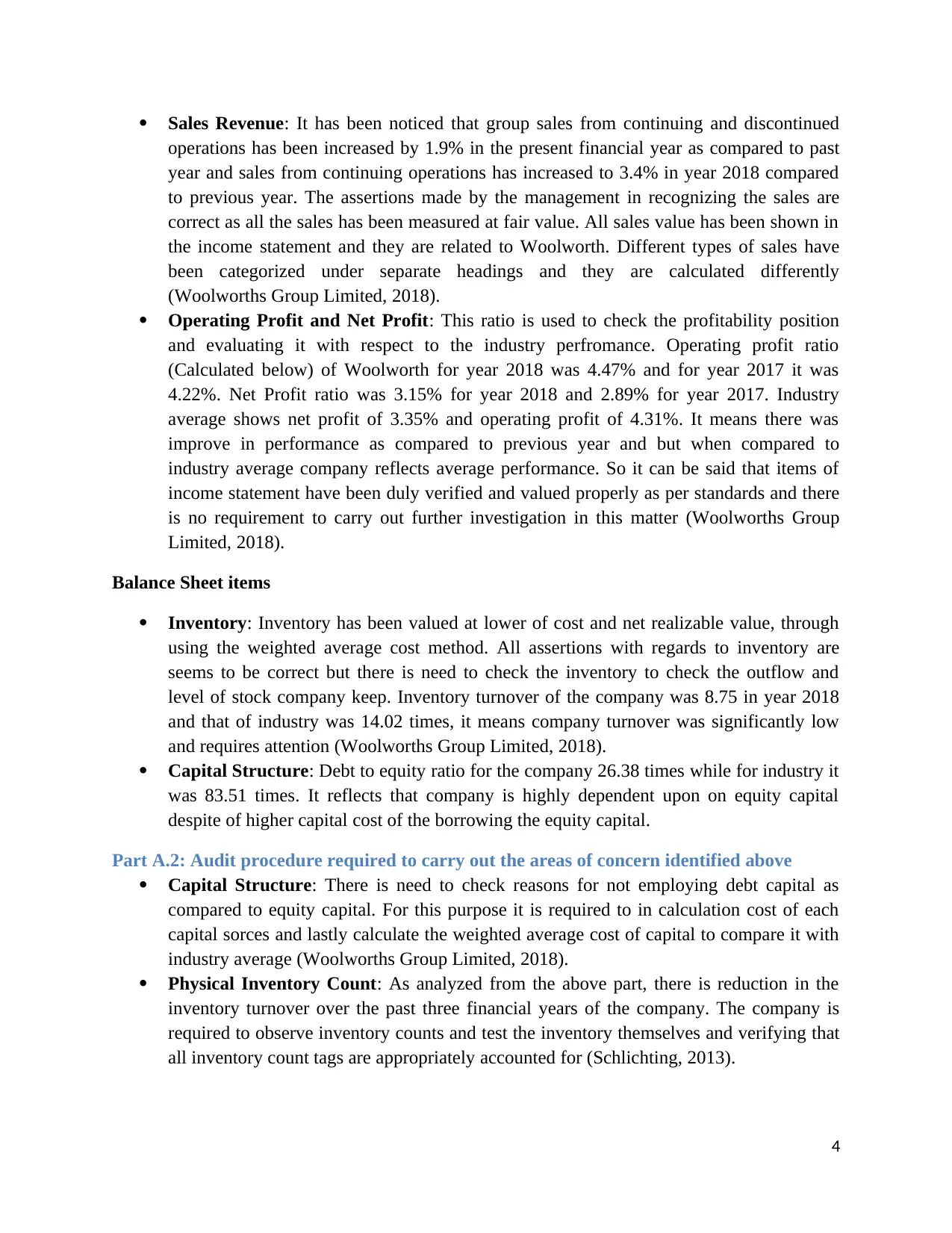
Sales Revenue: It has been noticed that group sales from continuing and discontinued
operations has been increased by 1.9% in the present financial year as compared to past
year and sales from continuing operations has increased to 3.4% in year 2018 compared
to previous year. The assertions made by the management in recognizing the sales are
correct as all the sales has been measured at fair value. All sales value has been shown in
the income statement and they are related to Woolworth. Different types of sales have
been categorized under separate headings and they are calculated differently
(Woolworths Group Limited, 2018).
Operating Profit and Net Profit: This ratio is used to check the profitability position
and evaluating it with respect to the industry perfromance. Operating profit ratio
(Calculated below) of Woolworth for year 2018 was 4.47% and for year 2017 it was
4.22%. Net Profit ratio was 3.15% for year 2018 and 2.89% for year 2017. Industry
average shows net profit of 3.35% and operating profit of 4.31%. It means there was
improve in performance as compared to previous year and but when compared to
industry average company reflects average performance. So it can be said that items of
income statement have been duly verified and valued properly as per standards and there
is no requirement to carry out further investigation in this matter (Woolworths Group
Limited, 2018).
Balance Sheet items
Inventory: Inventory has been valued at lower of cost and net realizable value, through
using the weighted average cost method. All assertions with regards to inventory are
seems to be correct but there is need to check the inventory to check the outflow and
level of stock company keep. Inventory turnover of the company was 8.75 in year 2018
and that of industry was 14.02 times, it means company turnover was significantly low
and requires attention (Woolworths Group Limited, 2018).
Capital Structure: Debt to equity ratio for the company 26.38 times while for industry it
was 83.51 times. It reflects that company is highly dependent upon on equity capital
despite of higher capital cost of the borrowing the equity capital.
Part A.2: Audit procedure required to carry out the areas of concern identified above
Capital Structure: There is need to check reasons for not employing debt capital as
compared to equity capital. For this purpose it is required to in calculation cost of each
capital sorces and lastly calculate the weighted average cost of capital to compare it with
industry average (Woolworths Group Limited, 2018).
Physical Inventory Count: As analyzed from the above part, there is reduction in the
inventory turnover over the past three financial years of the company. The company is
required to observe inventory counts and test the inventory themselves and verifying that
all inventory count tags are appropriately accounted for (Schlichting, 2013).
4
operations has been increased by 1.9% in the present financial year as compared to past
year and sales from continuing operations has increased to 3.4% in year 2018 compared
to previous year. The assertions made by the management in recognizing the sales are
correct as all the sales has been measured at fair value. All sales value has been shown in
the income statement and they are related to Woolworth. Different types of sales have
been categorized under separate headings and they are calculated differently
(Woolworths Group Limited, 2018).
Operating Profit and Net Profit: This ratio is used to check the profitability position
and evaluating it with respect to the industry perfromance. Operating profit ratio
(Calculated below) of Woolworth for year 2018 was 4.47% and for year 2017 it was
4.22%. Net Profit ratio was 3.15% for year 2018 and 2.89% for year 2017. Industry
average shows net profit of 3.35% and operating profit of 4.31%. It means there was
improve in performance as compared to previous year and but when compared to
industry average company reflects average performance. So it can be said that items of
income statement have been duly verified and valued properly as per standards and there
is no requirement to carry out further investigation in this matter (Woolworths Group
Limited, 2018).
Balance Sheet items
Inventory: Inventory has been valued at lower of cost and net realizable value, through
using the weighted average cost method. All assertions with regards to inventory are
seems to be correct but there is need to check the inventory to check the outflow and
level of stock company keep. Inventory turnover of the company was 8.75 in year 2018
and that of industry was 14.02 times, it means company turnover was significantly low
and requires attention (Woolworths Group Limited, 2018).
Capital Structure: Debt to equity ratio for the company 26.38 times while for industry it
was 83.51 times. It reflects that company is highly dependent upon on equity capital
despite of higher capital cost of the borrowing the equity capital.
Part A.2: Audit procedure required to carry out the areas of concern identified above
Capital Structure: There is need to check reasons for not employing debt capital as
compared to equity capital. For this purpose it is required to in calculation cost of each
capital sorces and lastly calculate the weighted average cost of capital to compare it with
industry average (Woolworths Group Limited, 2018).
Physical Inventory Count: As analyzed from the above part, there is reduction in the
inventory turnover over the past three financial years of the company. The company is
required to observe inventory counts and test the inventory themselves and verifying that
all inventory count tags are appropriately accounted for (Schlichting, 2013).
4
Paraphrase This Document
Need a fresh take? Get an instant paraphrase of this document with our AI Paraphraser
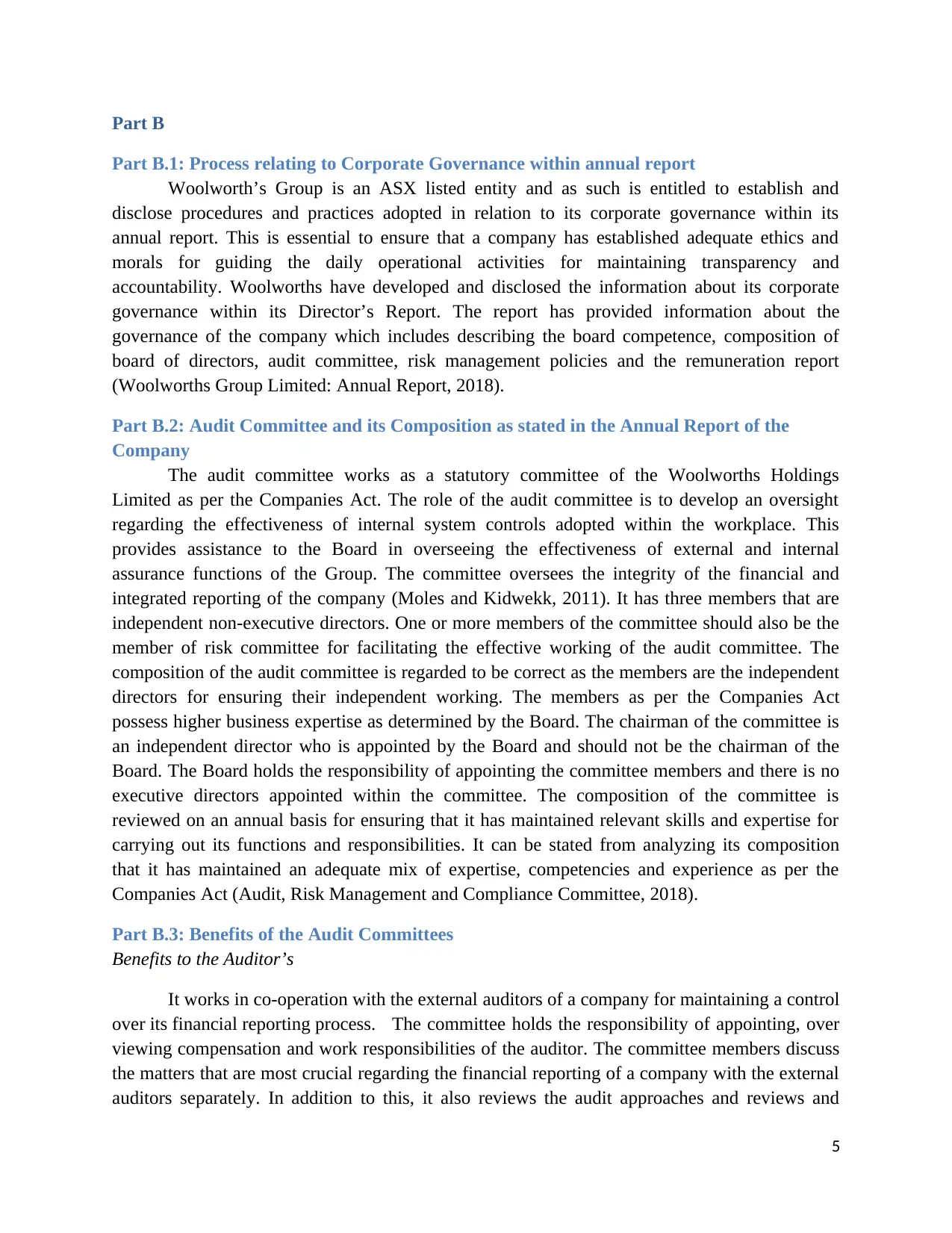
Part B
Part B.1: Process relating to Corporate Governance within annual report
Woolworth’s Group is an ASX listed entity and as such is entitled to establish and
disclose procedures and practices adopted in relation to its corporate governance within its
annual report. This is essential to ensure that a company has established adequate ethics and
morals for guiding the daily operational activities for maintaining transparency and
accountability. Woolworths have developed and disclosed the information about its corporate
governance within its Director’s Report. The report has provided information about the
governance of the company which includes describing the board competence, composition of
board of directors, audit committee, risk management policies and the remuneration report
(Woolworths Group Limited: Annual Report, 2018).
Part B.2: Audit Committee and its Composition as stated in the Annual Report of the
Company
The audit committee works as a statutory committee of the Woolworths Holdings
Limited as per the Companies Act. The role of the audit committee is to develop an oversight
regarding the effectiveness of internal system controls adopted within the workplace. This
provides assistance to the Board in overseeing the effectiveness of external and internal
assurance functions of the Group. The committee oversees the integrity of the financial and
integrated reporting of the company (Moles and Kidwekk, 2011). It has three members that are
independent non-executive directors. One or more members of the committee should also be the
member of risk committee for facilitating the effective working of the audit committee. The
composition of the audit committee is regarded to be correct as the members are the independent
directors for ensuring their independent working. The members as per the Companies Act
possess higher business expertise as determined by the Board. The chairman of the committee is
an independent director who is appointed by the Board and should not be the chairman of the
Board. The Board holds the responsibility of appointing the committee members and there is no
executive directors appointed within the committee. The composition of the committee is
reviewed on an annual basis for ensuring that it has maintained relevant skills and expertise for
carrying out its functions and responsibilities. It can be stated from analyzing its composition
that it has maintained an adequate mix of expertise, competencies and experience as per the
Companies Act (Audit, Risk Management and Compliance Committee, 2018).
Part B.3: Benefits of the Audit Committees
Benefits to the Auditor’s
It works in co-operation with the external auditors of a company for maintaining a control
over its financial reporting process. The committee holds the responsibility of appointing, over
viewing compensation and work responsibilities of the auditor. The committee members discuss
the matters that are most crucial regarding the financial reporting of a company with the external
auditors separately. In addition to this, it also reviews the audit approaches and reviews and
5
Part B.1: Process relating to Corporate Governance within annual report
Woolworth’s Group is an ASX listed entity and as such is entitled to establish and
disclose procedures and practices adopted in relation to its corporate governance within its
annual report. This is essential to ensure that a company has established adequate ethics and
morals for guiding the daily operational activities for maintaining transparency and
accountability. Woolworths have developed and disclosed the information about its corporate
governance within its Director’s Report. The report has provided information about the
governance of the company which includes describing the board competence, composition of
board of directors, audit committee, risk management policies and the remuneration report
(Woolworths Group Limited: Annual Report, 2018).
Part B.2: Audit Committee and its Composition as stated in the Annual Report of the
Company
The audit committee works as a statutory committee of the Woolworths Holdings
Limited as per the Companies Act. The role of the audit committee is to develop an oversight
regarding the effectiveness of internal system controls adopted within the workplace. This
provides assistance to the Board in overseeing the effectiveness of external and internal
assurance functions of the Group. The committee oversees the integrity of the financial and
integrated reporting of the company (Moles and Kidwekk, 2011). It has three members that are
independent non-executive directors. One or more members of the committee should also be the
member of risk committee for facilitating the effective working of the audit committee. The
composition of the audit committee is regarded to be correct as the members are the independent
directors for ensuring their independent working. The members as per the Companies Act
possess higher business expertise as determined by the Board. The chairman of the committee is
an independent director who is appointed by the Board and should not be the chairman of the
Board. The Board holds the responsibility of appointing the committee members and there is no
executive directors appointed within the committee. The composition of the committee is
reviewed on an annual basis for ensuring that it has maintained relevant skills and expertise for
carrying out its functions and responsibilities. It can be stated from analyzing its composition
that it has maintained an adequate mix of expertise, competencies and experience as per the
Companies Act (Audit, Risk Management and Compliance Committee, 2018).
Part B.3: Benefits of the Audit Committees
Benefits to the Auditor’s
It works in co-operation with the external auditors of a company for maintaining a control
over its financial reporting process. The committee holds the responsibility of appointing, over
viewing compensation and work responsibilities of the auditor. The committee members discuss
the matters that are most crucial regarding the financial reporting of a company with the external
auditors separately. In addition to this, it also reviews the audit approaches and reviews and
5
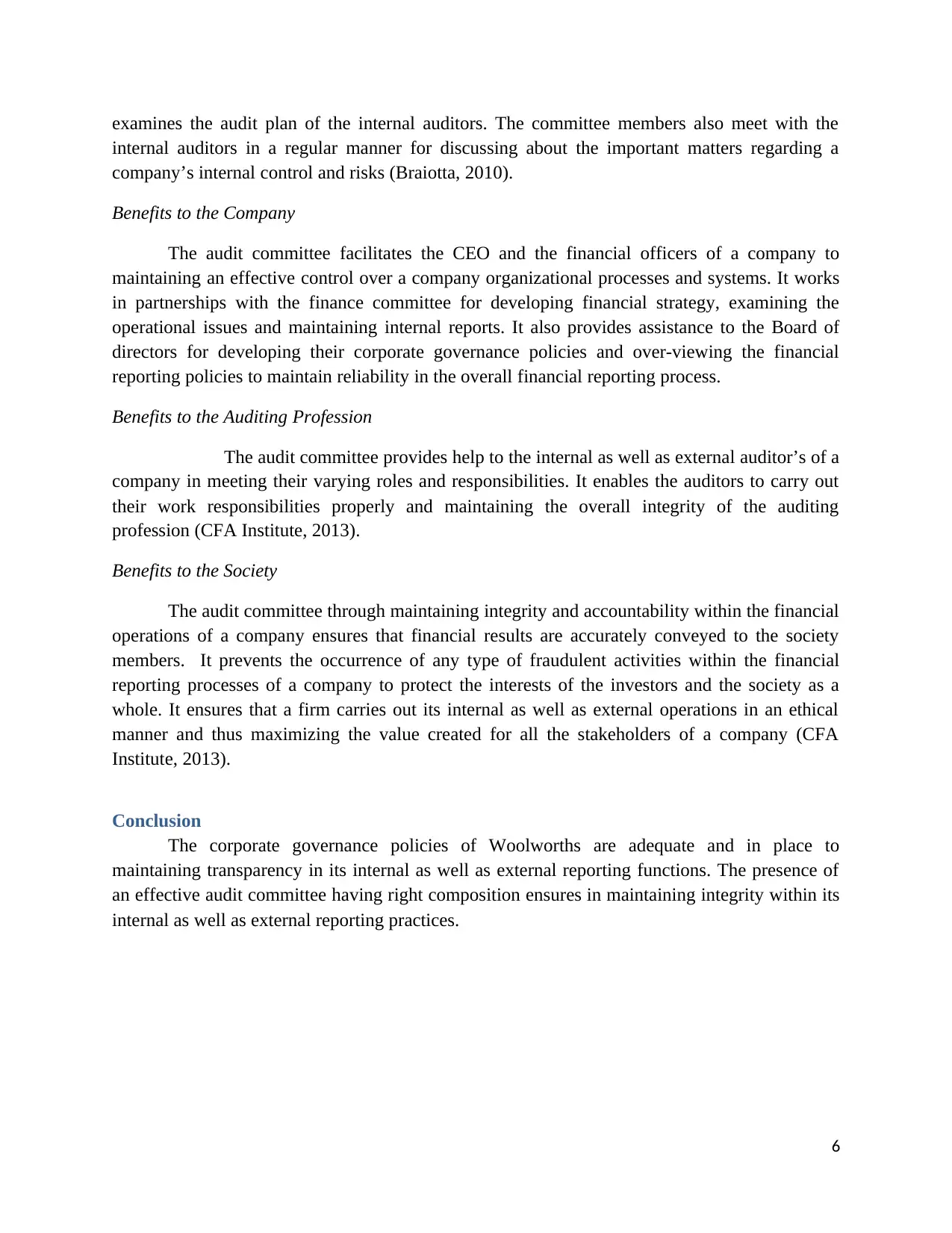
examines the audit plan of the internal auditors. The committee members also meet with the
internal auditors in a regular manner for discussing about the important matters regarding a
company’s internal control and risks (Braiotta, 2010).
Benefits to the Company
The audit committee facilitates the CEO and the financial officers of a company to
maintaining an effective control over a company organizational processes and systems. It works
in partnerships with the finance committee for developing financial strategy, examining the
operational issues and maintaining internal reports. It also provides assistance to the Board of
directors for developing their corporate governance policies and over-viewing the financial
reporting policies to maintain reliability in the overall financial reporting process.
Benefits to the Auditing Profession
The audit committee provides help to the internal as well as external auditor’s of a
company in meeting their varying roles and responsibilities. It enables the auditors to carry out
their work responsibilities properly and maintaining the overall integrity of the auditing
profession (CFA Institute, 2013).
Benefits to the Society
The audit committee through maintaining integrity and accountability within the financial
operations of a company ensures that financial results are accurately conveyed to the society
members. It prevents the occurrence of any type of fraudulent activities within the financial
reporting processes of a company to protect the interests of the investors and the society as a
whole. It ensures that a firm carries out its internal as well as external operations in an ethical
manner and thus maximizing the value created for all the stakeholders of a company (CFA
Institute, 2013).
Conclusion
The corporate governance policies of Woolworths are adequate and in place to
maintaining transparency in its internal as well as external reporting functions. The presence of
an effective audit committee having right composition ensures in maintaining integrity within its
internal as well as external reporting practices.
6
internal auditors in a regular manner for discussing about the important matters regarding a
company’s internal control and risks (Braiotta, 2010).
Benefits to the Company
The audit committee facilitates the CEO and the financial officers of a company to
maintaining an effective control over a company organizational processes and systems. It works
in partnerships with the finance committee for developing financial strategy, examining the
operational issues and maintaining internal reports. It also provides assistance to the Board of
directors for developing their corporate governance policies and over-viewing the financial
reporting policies to maintain reliability in the overall financial reporting process.
Benefits to the Auditing Profession
The audit committee provides help to the internal as well as external auditor’s of a
company in meeting their varying roles and responsibilities. It enables the auditors to carry out
their work responsibilities properly and maintaining the overall integrity of the auditing
profession (CFA Institute, 2013).
Benefits to the Society
The audit committee through maintaining integrity and accountability within the financial
operations of a company ensures that financial results are accurately conveyed to the society
members. It prevents the occurrence of any type of fraudulent activities within the financial
reporting processes of a company to protect the interests of the investors and the society as a
whole. It ensures that a firm carries out its internal as well as external operations in an ethical
manner and thus maximizing the value created for all the stakeholders of a company (CFA
Institute, 2013).
Conclusion
The corporate governance policies of Woolworths are adequate and in place to
maintaining transparency in its internal as well as external reporting functions. The presence of
an effective audit committee having right composition ensures in maintaining integrity within its
internal as well as external reporting practices.
6
⊘ This is a preview!⊘
Do you want full access?
Subscribe today to unlock all pages.

Trusted by 1+ million students worldwide
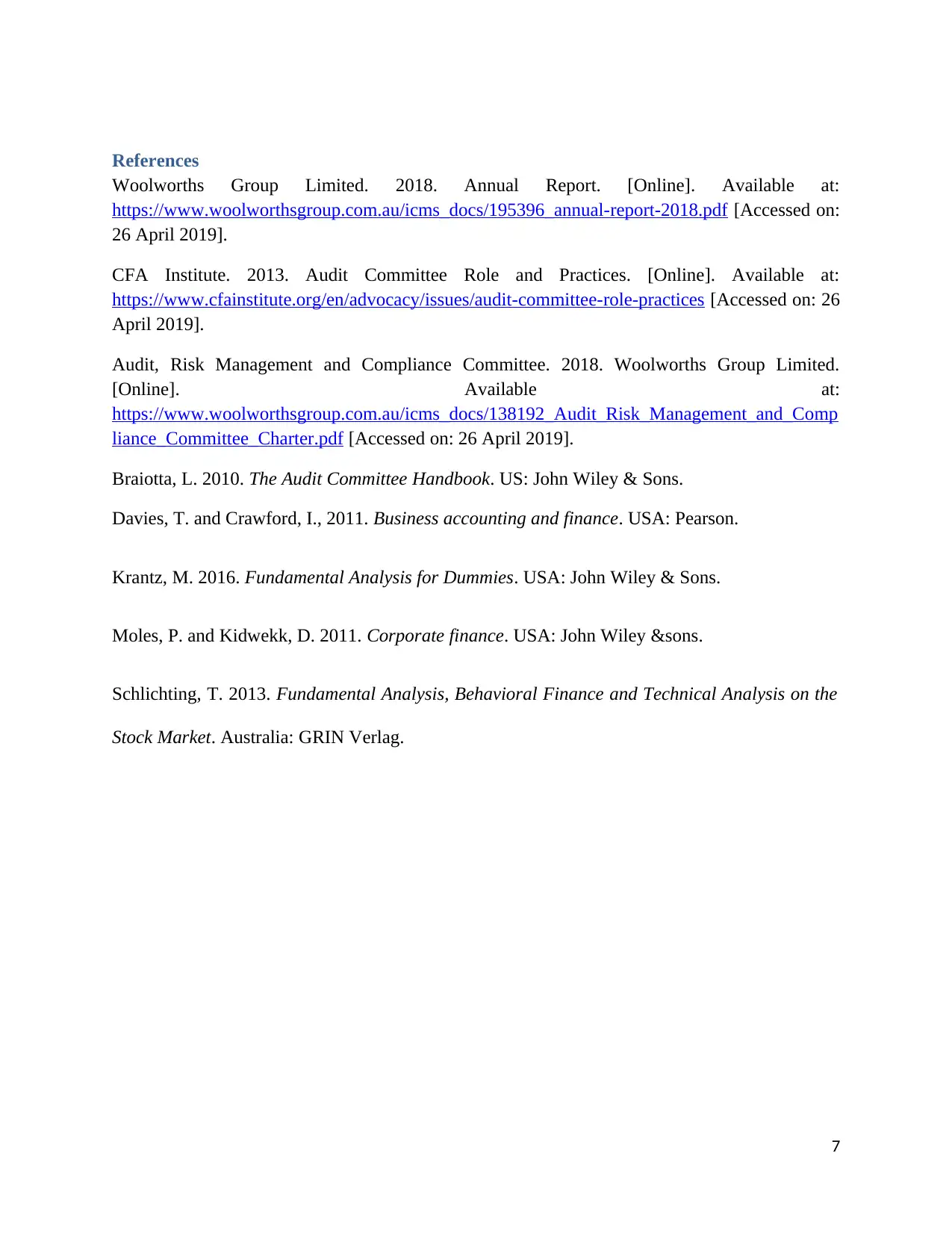
References
Woolworths Group Limited. 2018. Annual Report. [Online]. Available at:
https://www.woolworthsgroup.com.au/icms_docs/195396_annual-report-2018.pdf [Accessed on:
26 April 2019].
CFA Institute. 2013. Audit Committee Role and Practices. [Online]. Available at:
https://www.cfainstitute.org/en/advocacy/issues/audit-committee-role-practices [Accessed on: 26
April 2019].
Audit, Risk Management and Compliance Committee. 2018. Woolworths Group Limited.
[Online]. Available at:
https://www.woolworthsgroup.com.au/icms_docs/138192_Audit_Risk_Management_and_Comp
liance_Committee_Charter.pdf [Accessed on: 26 April 2019].
Braiotta, L. 2010. The Audit Committee Handbook. US: John Wiley & Sons.
Davies, T. and Crawford, I., 2011. Business accounting and finance. USA: Pearson.
Krantz, M. 2016. Fundamental Analysis for Dummies. USA: John Wiley & Sons.
Moles, P. and Kidwekk, D. 2011. Corporate finance. USA: John Wiley &sons.
Schlichting, T. 2013. Fundamental Analysis, Behavioral Finance and Technical Analysis on the
Stock Market. Australia: GRIN Verlag.
7
Woolworths Group Limited. 2018. Annual Report. [Online]. Available at:
https://www.woolworthsgroup.com.au/icms_docs/195396_annual-report-2018.pdf [Accessed on:
26 April 2019].
CFA Institute. 2013. Audit Committee Role and Practices. [Online]. Available at:
https://www.cfainstitute.org/en/advocacy/issues/audit-committee-role-practices [Accessed on: 26
April 2019].
Audit, Risk Management and Compliance Committee. 2018. Woolworths Group Limited.
[Online]. Available at:
https://www.woolworthsgroup.com.au/icms_docs/138192_Audit_Risk_Management_and_Comp
liance_Committee_Charter.pdf [Accessed on: 26 April 2019].
Braiotta, L. 2010. The Audit Committee Handbook. US: John Wiley & Sons.
Davies, T. and Crawford, I., 2011. Business accounting and finance. USA: Pearson.
Krantz, M. 2016. Fundamental Analysis for Dummies. USA: John Wiley & Sons.
Moles, P. and Kidwekk, D. 2011. Corporate finance. USA: John Wiley &sons.
Schlichting, T. 2013. Fundamental Analysis, Behavioral Finance and Technical Analysis on the
Stock Market. Australia: GRIN Verlag.
7
Paraphrase This Document
Need a fresh take? Get an instant paraphrase of this document with our AI Paraphraser
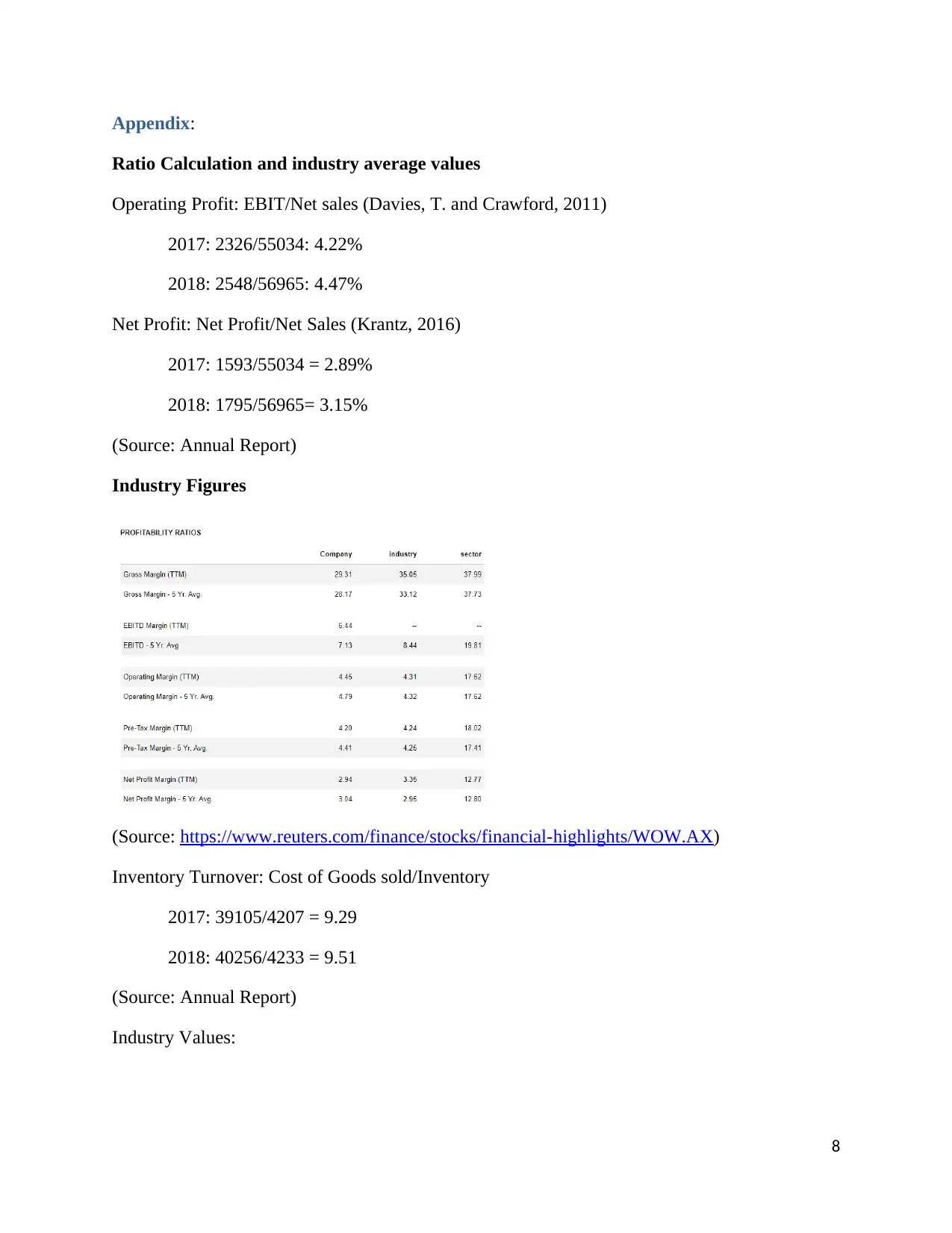
Appendix:
Ratio Calculation and industry average values
Operating Profit: EBIT/Net sales (Davies, T. and Crawford, 2011)
2017: 2326/55034: 4.22%
2018: 2548/56965: 4.47%
Net Profit: Net Profit/Net Sales (Krantz, 2016)
2017: 1593/55034 = 2.89%
2018: 1795/56965= 3.15%
(Source: Annual Report)
Industry Figures
(Source: https://www.reuters.com/finance/stocks/financial-highlights/WOW.AX)
Inventory Turnover: Cost of Goods sold/Inventory
2017: 39105/4207 = 9.29
2018: 40256/4233 = 9.51
(Source: Annual Report)
Industry Values:
8
Ratio Calculation and industry average values
Operating Profit: EBIT/Net sales (Davies, T. and Crawford, 2011)
2017: 2326/55034: 4.22%
2018: 2548/56965: 4.47%
Net Profit: Net Profit/Net Sales (Krantz, 2016)
2017: 1593/55034 = 2.89%
2018: 1795/56965= 3.15%
(Source: Annual Report)
Industry Figures
(Source: https://www.reuters.com/finance/stocks/financial-highlights/WOW.AX)
Inventory Turnover: Cost of Goods sold/Inventory
2017: 39105/4207 = 9.29
2018: 40256/4233 = 9.51
(Source: Annual Report)
Industry Values:
8
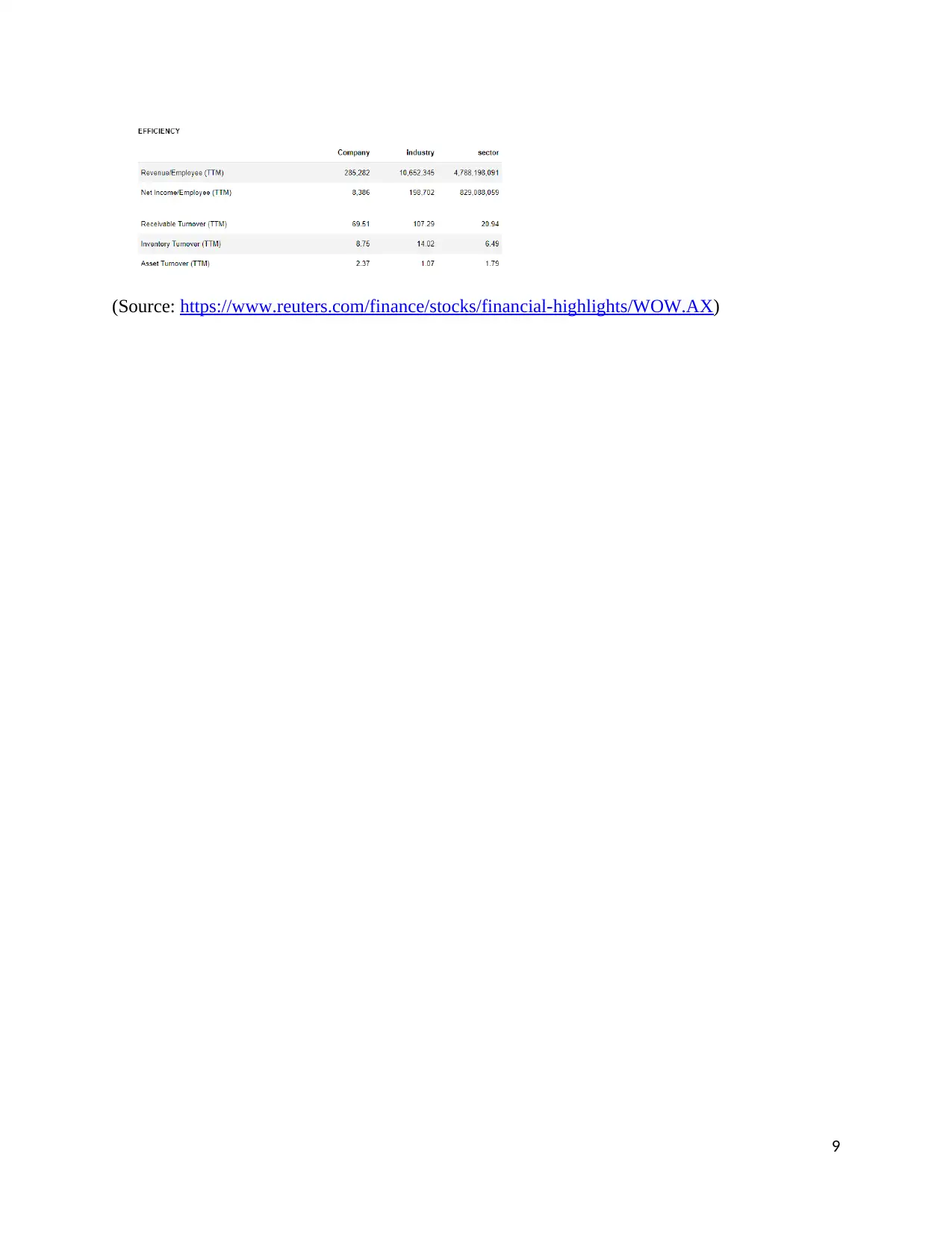
(Source: https://www.reuters.com/finance/stocks/financial-highlights/WOW.AX)
9
9
⊘ This is a preview!⊘
Do you want full access?
Subscribe today to unlock all pages.

Trusted by 1+ million students worldwide
1 out of 9
Related Documents
Your All-in-One AI-Powered Toolkit for Academic Success.
+13062052269
info@desklib.com
Available 24*7 on WhatsApp / Email
![[object Object]](/_next/static/media/star-bottom.7253800d.svg)
Unlock your academic potential
Copyright © 2020–2025 A2Z Services. All Rights Reserved. Developed and managed by ZUCOL.




